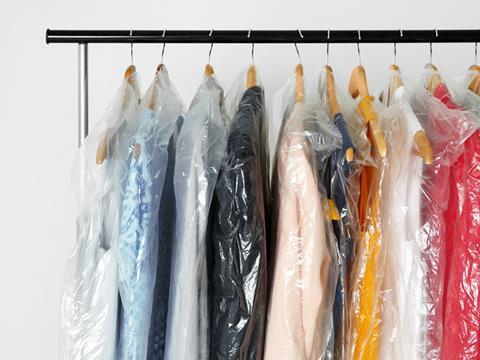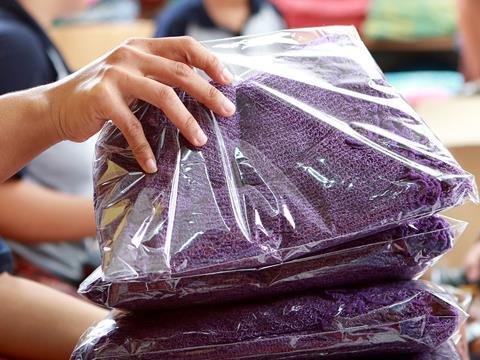Should we continue to use polybags in the fashion industry considering the rise of sustainable alternatives?
Ashley Holding, innovation manager at Fashion For Good and Adam Gendell, associate director of GreenBlue’s flagship project, the Sustainable Packaging Coalition, discuss findings from their joint whitepaper with Libby Munford.
LM: Ashley, I’d like to ask you how you define polybags and what their function is in the fashion industry?
AH: I think the word “polybag” could mean different things to different people. In the fashion industry it’s quite a widely understood term, used generally to refer to clear, PE film bags which garment manufacturers use to package their products. It’s something that really unites almost every kind of brand, from luxury brands to value retailers, sportswear and formal wear.
Almost everyone uses some form of polybag, and they’re really integral to the whole supply chain. I think that’s one really important thing to think about, and it’s really tied into logistics and supply chain elements as well. They go through distribution centres all the way to bricks and mortar retail stores, as well as consumers’ homes via e-commerce. Polybags are not always collected or recycled.
AG: I think, in today’s landscape, we hear a lot about eliminating problematic or unnecessary plastic packaging, namely through the Ellen MacArthur Foundation’s “New Plastic Economy” framework. What we’ve found is that polybags aren’t superfluous – they shouldn’t be considered unnecessary because the functions they provide in a complex supply chain are critical.
A few months ago, we sent out a survey to the audiences of Fashion for Good, the Sustainable Packaging Coalition, the Retail Industry Leaders Association, and the European outdoor group, and we heard from a number of companies in the fashion apparel space about polybags and what they need polybags to do. We found that, first and foremost, polybags are there to protect.
Protecting the garment is much more than making sure that it doesn’t get a little bit of dust on it – we’re talking about making sure they don’t get torn, scuffed or dirty. Moisture protection is right up there as well. I’ve been fascinated by a case study published by Patagonia, where they conducted a kind of science experiment by taking a few dozen garments and sending them through its distribution system without polybags. They found that something like a third of them came out the other side too damaged to sell. Of course, if we think about the relative impact of a couple of grams of polyethylene versus a full garment, I think everyone can understand the relative importance of making sure a garment is in a saleable condition.

LM: Why do you think there’s an eagerness at the moment from companies in the fashion and apparel sectors to focus on polybags? What are the issues surrounding them and their use?
AG: I find this groundswell of interest really fascinating. We know that there’s a lot of attention on single-use packaging – that’s not new news. But I think we can trace all of this scrutiny back to one monolithic issue: marine plastic pollution, and the terrible images that we all see constantly. However, I’ve never seen a polybag in any of those pictures, so it strikes me that the polybag isn’t the straw, or the foam take-out container, or the plastic shopping bag – the symbols of single-use plastic packaging and marine plastic pollution.
But, at the same time, it hasn’t just been a couple of companies here and there that have said that they are addressing polybags – there’s a real critical mass of companies out there that all share the same high level of interest in doing something around polybags.
I think what we’ve learned is that the industry is being proactive here. They know just as well as we do that polybags in the fashion industry aren’t the plastic straw or the foam take-out container. But they are the main symbol of plastic single-use packaging within the fashion industry.
If I think about fashion and apparel packaging in general, it’s actually refreshingly straightforward from my perspective – when compared with the different types of packaging that an FMCG company would use. We’ve got corrugated boxes, polybags, and then you might have some sort of hang tag. So, in a sense, I think the industry is being proactive about addressing this before it becomes the new biggest issue around plastic packaging.
Another thing we’ve learned is that a lot of brand owners and retailers have zero-waste goals. And, right now, polybags aren’t in a very circular system. Most of them are made from 100% virgin material and there are a number of challenges related to capturing them and getting them into the recycling stream after they’ve been used. So, from a zero-waste perspective, today everybody has polybags, and nobody has closed the loop on polybag waste.
AH: I think one thing that is difficult to understand is the exact scale of the packaging footprint. There’s really not a good amount of data on how many polybags are produced each year but, based on some estimates we’ve seen, hundreds of billions of garments are produced each year. If we assume that each of these has a polybag attached to it, then there are probably hundreds of billions of polybags.
I think it’s important to put this into a bit of perspective – they are very thin and light compared to the garments that are inside them, so you might have a polyester sweater in a polybag which is many, many times heavier than the bag itself, and contains way more plastic.
LM: You’ve just discussed some really key issues with regard to sustainability. How is the industry reacting to this and what do you think the solution is?
AH: We polled some of our members to see what they were thinking. The answers depend on what their priorities are, and these constantly change. We’ve seen that some prioritise recyclability and end-of-life waste management, some of them prioritise reducing the amount of plastic overall, and some look at reducing total carbon emissions.
But, to be honest, they seem to rank these things below simply reducing the amount of overall plastic usage. Consequently, most of the initiatives we’ve seen have been based on things like reducing plastic, through reducing polybag size, incorporating recycled content, and collecting polybags for recycling. Only a minority of brands – around a third – are doing these initiatives, and then there’s a bunch of other initiatives looking at compostable polybags, paper-based alternatives, and master polybags.

AG: What I found really interesting about the responses we received from our audiences when we sent out the survey is that there’s a nice synergy in the priorities the industry is placing on polybags. I don’t think it’s surprising that circularity attributes rose to the top of everyone’s lists. People look at the issue of polybags as an issue of waste, waste recovery, and closing the loop at the end of life. A not-too-distant second from that is the idea of using fewer polybags or reducing their gauge and size and finding ways to reduce their use altogether from certain sections of the supply chain. I was also surprised to see that carbon footprint came in third place in terms of how much importance was placed on it by our audiences.
We often advise companies to be on the lookout for conflicting priorities, and the risks of unintended consequences because we want companies to take a multifaceted approach and not just think of it as a single issue that needs to be addressed.
LM: On that note, what stands out to you in terms of how brands are focusing their activities, and what more can be done?
AG: What concerns me is that a lot of those conversations start with a statement along the lines of: “We want to fix this polybag issue and we understand we need to find an alternative. We’ve stopped using them, and we want to replace them with alternative designs and materials.” The first piece of advice I always give to these companies is, while there might be a lot of advantages to alternative polybag designs, these will only ever be as sustainable as the systems surrounding them enables them to be.
If you’re using a different material that might introduce performance trade-offs as far as moisture barrier properties, or tear and puncture resistance, you really ought to consider what corresponding moves need to be made to your line speed or worker practices when they’re filling boxes. Similarly, if you’re transitioning to a compostable design, you should really think about the systems in place that are there to get that polybag to a composter.
So, I do think there’s a lot to be said for retaining the existing polybag, which has been highly engineered and is good at all the “jobs” it needs to do. We need to put a lot of emphasis on the systems around it, on the practices that can be put in place to get polybags collected and recycled after they’re used.
The results of these surveys really have been encouraging – the industry is taking a very level headed approach and, before anything else, they are asking the question: “How do we use less?” We know that we need polybags, but do we need them for absolutely everything, or are there creative ways to get rid of them in certain instances and circumstances? Again, can we use smaller polybags that more tightly fit the garment without wasted space and material?
AH: Like Adam said, rather than focusing on reducing or eliminating plastics, I think we should really be focusing on the systems. Something Fashion For Good has been looking at in detail is the implementation of a circular system where polybags are collected from distribution centres and retail stores, and then recycled into high-quality products like new polybags.

LM: Since plastic exploded in the media, there has been a strong move towards finding alternative materials. Do you think that’s the best pathway, or should the conventional polybag become a thing of the past?
AH: From my side, I think conventional plastics still have an important role to play. It is possible to recycle polyethylene and not necessarily distribute it so well, even in a market like North America. Recycling systems are being set up across the world, and it’s becoming more feasible to recycle polyethylene with current and emerging technologies. The second point is that you can source polyethylene from biological feedstocks, so you can have bio-based PE which is chemically the same as PE from petroleum-based sources and can be recycled in the same way.
You can also use a mixture of bio-PE and recycled PE and, from a carbon impact perspective, both those options are quite good. Bio-based PE bags are available now, many companies sell them. They are based on sugar cane as a feedstock and are sold by a company called Braskem.
AG: I agree with Ashley – we also appreciate the diversity of approaches that companies are taking. I think both things can be true – the conventional can have a brighter future and there are also good opportunities for alternative materials and designs to come in and push innovation as well. I don’t think that anybody knows enough to say that “option B” is always going to be the best, in every region and in every circumstance for every type of product.
When we polled our audiences on what kind of improvements they were exploring and implementing, we measured more interest in reusable packaging than anything else. Our numbers showed us that basically every single company is at least thinking about some type of reusable packaging system that would serve the same function as polybags but may look completely different. But at the same time, when we ask them what they’ve actually implemented, hardly any companies actually had reuse systems in place.
I think our research suggests a multi-pronged short-term and long-term approach.
LM: You’ve explored some of the alternatives that are options on the market, but there must be pros and cons to these alternative materials. Can you discuss these?
AG: Any material is going to have a different profile of environmental attributes, and that extends beyond this discussion on polybags. One of the first learnings to be found in the whole galaxy of sustainable packaging is that there’s not going to be one “silver bullet” material or design format that’s going to “win” across the board if you look at all the different and important environmental characteristics.
The conventional polyethylene design is, frankly, not that impact-intensive – we’re talking a very small amount of polyethylene. That said, we’re also talking potentially billions of small amounts of polyethylene every year, which turns into a lot of polyethylene.
So, there’s a meaningful carbon footprint at play in polybags. The amount of fossil resource consumption is meaningful – water consumption, toxicity indicators, all of those.
AH: The trade-offs often come in terms of waste management. Most countries don’t have a separate collection system for compostable plastics. I think it’s also important to understand the volume of polybags being used by large brands. You’d have many tonnes of compostable plastics going through a distribution centre which wouldn’t really have a place to go – it would essentially be incinerated or landfilled.
So, thinking about the lifecycle of materials before they are put on the market is very important. As was mentioned, using bio-based alternatives for current materials is a good way to reduce carbon impact. Paper is also interesting – it can be recycled pretty widely in most countries. There is a slight trade-off in terms of carbon emissions and water usage. Then there are new materials, like PVA, which is a water-dissolvable polymer and also has trade-offs in carbon emissions and water usage.
LM: Which of these alternative materials do you see receiving the most interest on the market at the moment?
AH: For me the compostable options are quite interesting for a lot of people and I think it really depends on the brand itself and what message it’s trying to convey. You actually see more small brands (which we define as less than $1 billion in revenue) focusing on compostable alternatives. They’re also interested in the idea of participating in the biological cycle. Of course, the realities behind this today aren’t quite there.
Another thing that is interesting, if still quite new, are the water-dissolvable PVA polybags that I talked about earlier. I think it’s still very early days – they claim to be compostable but, to be honest, I haven’t seen specific evidence of this. I’m happy to stand corrected if there are some. We do need to exercise caution until there’s more data on its compostability and compatibility with current recycling streams and plants.
Also, as we mentioned before, I think a pretty good option, for now, is bio-based and recycled PE.

AG: I love this question because I actually find it very challenging to answer. I don’t think we’ve seen any kind of critical mass forming around one particular alternative to the conventional polybag. I think Ashley and I have done a great deal of exploration to find out who’s doing what, and I feel like we’ve found single examples of a company using each of these main categories of alternatives.
So, we can find one brand owner who’s using the sugarcane-based polyethylene, another brand owner who’s using a compostable plastic alternative. I think the paper alternatives are going to be interesting to watch, because they’re probably the newest entry into the market here and, just in general with the scrutiny around single-use plastic packaging, the paper alternative tends to be one of the things companies want to explore. So, I’m not going to be surprised if we see some good healthy uptake of the paper alternative as well.
All that said, I want to reinforce a point I introduced earlier, which is that for every company that is looking to change material, there’s multiple companies who are attacking this as more of a systems challenge and asking what they can do without these polybags and how they can change the system. They’re looking at what happens at their distribution centres – they have a good ability to collect polybags there and they can deal with the film recycler. They want to know if it’s possible to do things like using polybags until that last leg of shipment, and then ship them without a polybag, so that they can be kept at the distribution centre where they can be aggregated and recycled.
We’re also seeing companies looking at down-gauging and incorporation of recycled content, so again, there’s not really any gravitation towards one of these alternative options.
I also think it’s worth mentioning that there’s a lot of sharing going on as well, which is really nice to see – a lot of pre-competitive cooperation so that companies can say: “This is what we’re doing now, this is what we like about it, and here are the challenges we’ve discovered.”
LM: It sounds like you’re seeing quite a joined-up approach on these issues. What do you think the solution is and where do you think we’ll go with this in the future?
AH: This is really what we’ve been focusing on at Fashion For Good. We accepted that polyethylene is being used right now, so it’s probably a good idea to make the current system better. Firstly, we should always start off with reducing plastic where necessary and where possible. There are some ways in which you can eliminate it as well, especially before it’s sent to consumers. Exploring ways to remove polybags in distribution centres before they’re sent to consumer could also be quite a good idea.
In line with these things, we should also be establishing collection of waste and making sure this is actually recycled, as well as ensuring that stores, in particular, collect and recycle their polybag waste. We’ve seen that some more traditional retailers and brands have quite a large volume of polybag waste – sometimes 80% of its whole volume of waste – actually at store-level.
AG: I think, from an ideal sustainability perspective, the best solution is going to be worked out on a really long wavelength – it’s going to take time. I also think everyone shares the same long-term pursuit of a world without polybags, where the short term strategy is to enhance their circularity, but the long term strategy is to change whatever needs to be changed, so that we don’t even have to ask what the best polybag looks like.
I don’t think we’re going to have billions of reusable unitised polybags – the system is going to be different. It might be a whole bunch of garments together in one reusable shipper – who knows? Again though, in the meantime, I think the diversity of approaches we’re seeing about perfecting circularity and finding fits for alternative designs is going to contribute to everyone’s understanding.
AH: I like the idea of a “master polybag”. It is vital for some brands to have one larger bag which contains many garments, and it’s something that a lot of larger retailers are doing. This reduces overall plastic waste and is a fairly viable solution.
Listen to the conversation in full on the latest Packaging Europe podcast.
Available on our homepage, Apple Podcasts, and Spotify.















